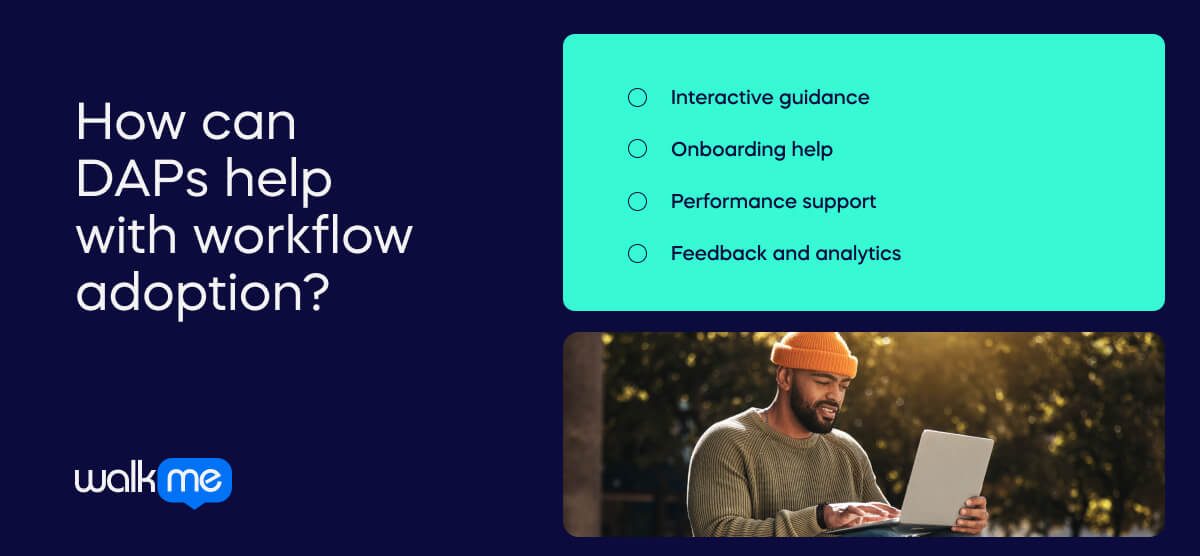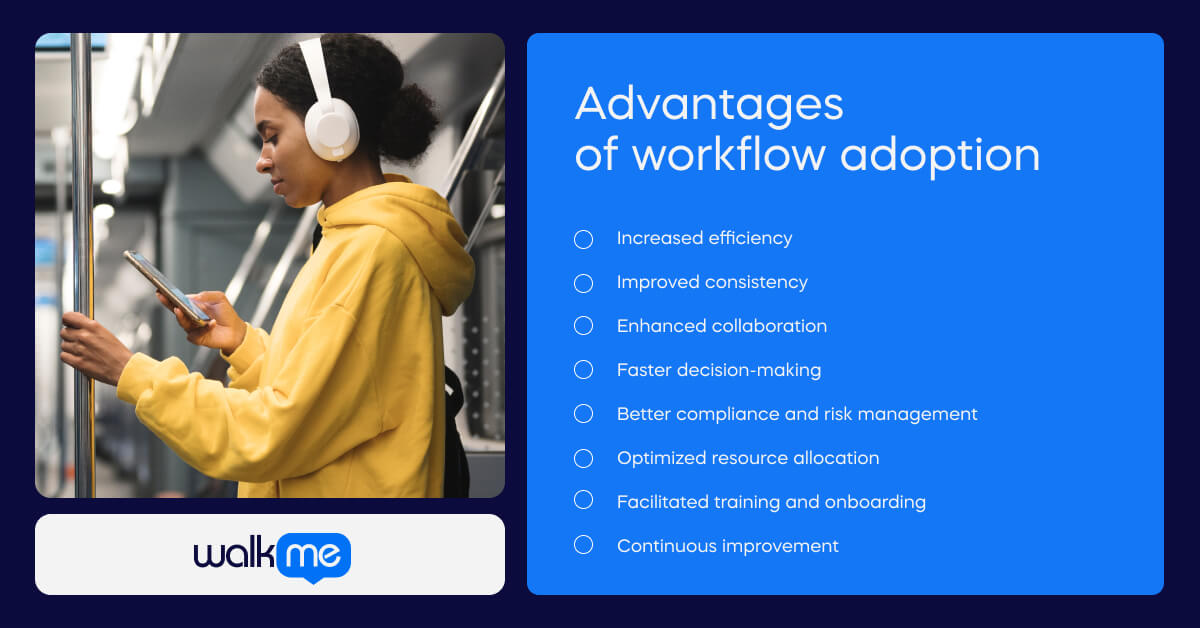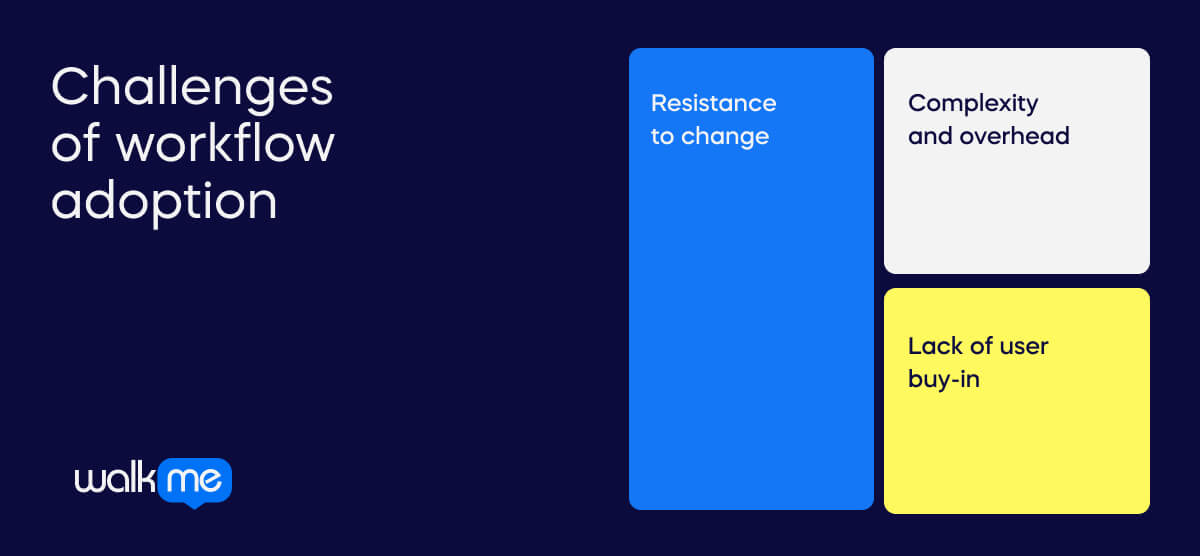What is workflow adoption?
Workflow adoption is the process of making new workflows in an organization. It involves employees or team members accepting, using, and integrating these workflows.

Table of contents
Successful workflow adoption often requires effective communication, training, and support from management. Employees need to understand the new processes and feel comfortable using them.
The adoption may also involve adjustments to existing systems or technologies. This accommodates the new workflows.
The goal of workflow adoption is to streamline processes. This results in improved efficiency, productivity, and effectiveness within the organization. It can also lead to better collaboration, communication, and alignment among team members.
Workflow adoption for digital transformation
Workflow adoption is fundamental to digital transformation and organizational efficiency.
When organizations undergo digital transformation, they introduce new technologies and systems.
Yet, the success of these initiatives is not guaranteed. It depends on how well employees adopt the new workflows.
Effective adoption ensures that these processes become part of daily operations. As a result, organizations enjoy increased productivity and efficiency.
Successful adoption also maximizes the return on investment (ROI) of digital transformation initiatives.
Organizations invest significant resources in implementing digital solutions. Ensuring their adoption is crucial for realizing the full potential of these investments.
Furthermore, successful workflow adoption requires employees to adapt to change. This is an issue for many businesses. A recent WTW study reveals that only 43% of employees believe their organization is good at managing change.
In essence, organizations should assist with smooth transitions. They should also foster a culture of change management. They will be better equipped to thrive in today’s business environment by doing so.
How can DAPs help with workflow adoption?

Digital adoption platforms (DAPs) like WalkMe are important for helping with workflow adoption.
These tools help with workflow automation. This process helps to reduce manual effort and makes workflow adoption more appealing. The workflow automation market is booming. Mordor Intelligence reveals that it is set to reach $34.18 billion by 2029.
Here are several ways in which WalkMe can support and enhance workflow adoption:
Interactive guidance
WalkMe excels at providing interactive, step-by-step guidance within the workflow. This includes:
Tooltips: These appear when users hover over specific elements. They explain what an element is for, or how to use it.
Smart Walk-Thrus: These are guided tours that lead users through a process. They ensure that people understand how to navigate the workflow well.
Onboarding help
For new users, WalkMe offers tailored onboarding support:
Contextual guidance: WalkMe provides in-app guidance in real-time during onboarding. As a result, new employees understand the specific workflow they need to adopt.
Performance support
WalkMe assists users in overcoming obstacles during workflow interactions:
Troubleshooting tips: When users encounter issues, WalkMe can offer SmartTips. These help people understand a feature. Or, they are directed to relevant resources.
Knowledge bases: These are available within the workflow. Users can resolve their issues without any difficulty as a result.
Feedback and analytics
WalkMe provides robust feedback and analytics capabilities:
User interaction tracking: WalkMe collects data on user interactions with the workflow. The feature tracks usage patterns, common bottlenecks, and areas for improvement.
Insights and reports: Organizations gain valuable insights through analytics dashboards and reports. This enables data-driven decisions.
Use cases for workflow adoption
Workflow adoption in business
Here are three examples of how workflow adoption can appear in business.
Sales process optimization
In a sales organization, a new workflow needs to be adopted when a CRM is introduced. Initially, sales representatives might resist the change due to unfamiliarity or perceived complexity.
DAPs allow for interactive guides to be provided within the CRM interface. This helps sales reps to understand the new workflow. They also learn how to use the system. Skills they pick up include managing leads, opportunities, and customer interactions.
As sales reps become more comfortable with the CRM, they start to see improvements. Success with their efficiency, data entry, and lead nurturing can be found. This leads to increased sales performance and revenue generation for the business.
HR onboarding process streamlining
A company is revamping its HR onboarding process. They want to improve the experience for new employees. Furthermore, they need to ensure compliance with company policies and regulations.
The company decides to introduce a new digital onboarding platform. New hires are guided through a streamlined workflow. They complete necessary paperwork, watch training videos, and set up their employee profiles.
HR administrators can improve the process with a digital adoption platform. They can track employee progress, identify any issues and provide personalized help.
This results in faster onboarding times and reduced administrative overhead. What’s more, the company provides a smoother transition for new employees.
Manufacturing process optimization
A manufacturing company is rolling out a new workflow. It is designed for quality control inspections on the production line.
Digital adoption platforms are used to train operators on the new inspection procedures. They provide interactive guides and simulations to help them understand the steps involved. Plus, operators learn how to identify and address quality issues.
Over time, operators become more proficient in conducting inspections. As a result, the company observes a decrease in defects, rework, and production delays. This leads to higher product quality. The business also benefits from improved customer satisfaction and cost savings.
Success stories with workflow adoption
Here are some examples of organizations that have used WalkMe for workflow adoption:
Blackwoods
Blackwoods wanted a solution to onboard staff and train them. It was important the fix was practical and effective.
The company worked with WalkMe and rolled out a tailored change management solution. It featured training materials and automation. The company was able to streamline workflows, save time and automate tasks.
Employees migrated to Microsoft Dynamics with 1.5 days of self-guided lessons. This equates to a 50% faster time-to-proficiency.
TUI
TUI Group was rolling out new human capital management software. They needed to streamline the onboarding process for 35,000 employees.
With WalkMe’s help, employees were empowered to learn at their own pace. They could go through the modules with in-app guidance and advanced tooltips. This helped them understand unfamiliar concepts and assisted with entering accurate information.
As a result of partnering with WalkMe, TUI has seen positive metrics. These include a 70% cut in costs for time and travel, a 50% drop in support tickets, and a 40% rise in task completion rates.
Workflow adoption vs process adoption
Workflow adoption and process adoption are related concepts. However, they have their own distinct focuses within organizational change and improvement:
- Workflow adoption involves accepting and integrating specific sequences of tasks or activities
- Process adoption is accepting and rolling out business processes or methodologies. It is done with a wider outlook.
Both concepts are essential for organizational improvement and efficiency. However, they operate at different levels of granularity within the organization.
Let’s take a closer look:
| Workflow adoption | Process adoption | |
| Definition | Adopting a particular workflow or sequence of steps. The aim is to achieve a specific goal or outcome | Adopting an entire business process or methodology. It may involve multiple workflows across different departments or functions |
| Scope | Focuses on accepting specific sequences of tasks or activities within an organization | Focuses on the adoption of overarching frameworks or methodologies within an organization |
| Emphasis | Accepting and using tools, systems and methodologies associated with the prescribed workflow | Cultural and organizational changes necessary to embed new ways of working. This includes changes in mindset, behavior and organizational structure |
| Goal | Enhancing efficiency and effectiveness by streamlining specific tasks or activities | Improving overall organizational performance and achieving strategic objectives. This is done through the implementation of best practices |
| Examples | Adoption of a new CRM system, onboarding process, manufacturing inspection procedure | Adoption of Lean Six Sigma, Agile, Total Quality Management methodologies |
Advantages of workflow adoption

Workflow adoption offers several advantages to organizations, including:
Increased efficiency: Adopting specific workflows can streamline processes, reduce redundancies, and eliminate bottlenecks. This leads to increased efficiency in completing tasks and achieving objectives. By following predefined sequences of steps, employees can work more consistently and productively.
Improved consistency: Standardized workflows ensure that tasks are performed consistently across the organization. This reduces errors and variability in outcomes. This consistency enhances quality assurance and customer satisfaction. It ensures that reliable and predictable results are delivered.
Enhanced collaboration: Workflow adoption facilitates collaboration among team members. It does this by providing clear guidelines for each step of a process. By understanding their roles, employees can coordinate their efforts better. This leads to smoother collaboration and better teamwork.
Faster decision-making: Clearly defined workflows enable faster decision-making. The framework is structured. It helps people to evaluate options, gather info, and take action. This accelerates the pace of operations. What’s more, it enables organizations to respond more quickly to changing circumstances.
Better compliance and risk management: Standardized workflows help ensure compliance with regulatory requirements. They incorporate necessary checks and approvals into the process. This reduces the risk of non-compliance. The consequences would be potential legal or financial consequences for the organization.
Optimized resource allocation: By removing inefficiencies in workflows, organizations can optimize resource allocation. This enables them to allocate resources more effectively. They can focus on activities that deliver the most value.
Facilitated training and onboarding: Standardized workflows simplify the training and onboarding process. New employees are given clear guidelines and documentation on how tasks are performed. This reduces the time and resources required to get new hires up to speed. It also increases their productivity sooner.
Continuous improvement: Workflow adoption fosters a culture of continuous improvement. It provides a baseline for evaluating performance and identifying areas for optimization. By regularly reviewing and refining workflows, organizations can stay competitive. They do this by adapting to changing requirements, technologies, and market conditions.
Challenges of workflow adoption

Workflow adoption offers many benefits. However, organizations may face several challenges in implementing and maintaining standardized processes. Some of these challenges include:
Resistance to change: Employees may resist adopting new workflows. Reasons can include fear of the unknown or concerns about job security. They may also be uncomfortable with changing established routines. Overcoming resistance to change requires effective communication, training, and support. Companies need to help employees understand the rationale behind the new workflows. What’s more, they need to communicate how employees will benefit from them.
Complexity and overhead: Implementing standardized workflows can be complex and time-consuming. This is particularly the case in large organizations with diverse processes and systems. It may require significant upfront investment in technology, training, and change management initiatives. Maintaining workflows can also add to the administrative overhead and resource requirements.
Lack of user buy-in: Employees may not be motivated to embrace the changes. They may not see the value in adopting new workflows. Or, they could perceive them as unnecessary or cumbersome. Companies need to build buy-in and support. They can do this by engaging employees early in the process. They can also ask for their input. Plus, they can demonstrate the benefits through pilot projects or success stories.
Future of workflow adoption
Workflow adoption helps businesses to enhance efficiency, collaboration and consistency. It integrates standardized sequences of tasks or activities.
Digital adoption platforms (DAPs) play a pivotal role in facilitating this adoption. They provide interactive guidance, personalized support, and performance insights. These features help users navigate new workflows.
Companies like WalkMe have demonstrated the transformative impact of DAPs on workflow adoption. They enable organizations to overcome various challenges. These include slow time-to-proficiency and suboptimal task completion rates.
Looking ahead, the future of workflow adoption holds tremendous potential. It is assisted by the continued evolution of digital adoption platforms. As organizations embrace digital transformation, DAPs will play an even more critical role.
The synergy between workflow adoption and digital adoption platforms promises to empower organizations. They will be able to adapt, innovate, and thrive in an ever-changing business landscape.